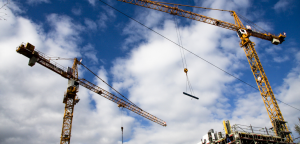Are you planning on setting up a temporary or permanent structure, or looking to place a working platform on a site? If this is the case, then knowing whether the ground can support the weight of the load placed on it is important. The plate testing (also called plate loading test) can help provide the answer.

What is plate testing?
When it comes to civil engineering projects, there will inevitably be a need to carry out one or more tests. One of these might be the need to test the soil to determine its capacity for bearing a heavy load. If a heavy load is set on the ground, there is a possible chance that it might cause the soil to subside. If this should happen, there is a risk of danger. This is where plate testing can help. By applying different loads to the ground, the test offers a way to measure how much weight the soil can safely support. Knowing how much weight can be safely supported reduces the risk of shear failure in the soil. As well as being reliable and cost-effective, plate testing also offers the advantage of being easy to perform.
When it comes to testing soil strength, there are two types of tests available. They are the plate load test and the California Bearing Ratio (CBR) test. Where soils have a harder texture or have larger particle sizes, measuring the load capacity will require a plate test. CBR testing is different. In road and pavement designs, the materials used are much finer. In these type of designs, testing will likely involve a CBR test rather than a plate test.
Where is it used?
In any civil engineering project where there is a need for plate testing, the process is likely to occur in two areas. The first relates to temporary buildings and structures. Here it supports testing the bases and shallow foundations. The second area involves the design and safety testing of crane bases, piling mats and working platforms.
What is the test process?
The plate test involves a steel plate, a deadweight and a hydraulic jack. The process takes place on-site. Each test can take around 2 hours to carry out. As soil conditions may change during the day, there may be a need to carry out 4-6 tests over a period of time. The process used in the test is set out in the industry standard, BS 1377 Part 9: 1990.
Plate testing involves placing a steel plate on the ground, either on the surface or in a shallow pit. The size of the steel plate used in the test is always of a known size. The minimum size of the plate used is at least 300mm, although it can be larger. How big the steel plate is will depend on the test’s scope, the load involved and the site conditions.
Applying pressure to the plate involves the use of a hydraulic jack and a deadweight. The pressure is steadily increased in increments during the test. The deadweight is usually some form of plant machinery. Given the weight required, it is often something like a tracked excavator which can weigh anything from 8tonnes and upwards. Applying pressure to the plate using the hydraulic jack causes the soil to subside. By measuring the movement, it is possible to calculate how much load the soil can handle.
Plate test limitations
And finally, while plate testing is a proven method for testing the load capacity of soils, it has limitations.
Those limitations include:
- It can only return results on soils that are a depth of twice the diameter of the steel plate.
- There is a risk that the results may not provide all the necessary information about how the soil might settle over a longer period.
- As the test plate size is smaller than the actual foundation, the results mean that there is a scale effect involved.
- To carry out the test there may be a need to excavate to allow access to the test position. The excavation could cause ground disturbance and alter the results of the test.







Add Comment